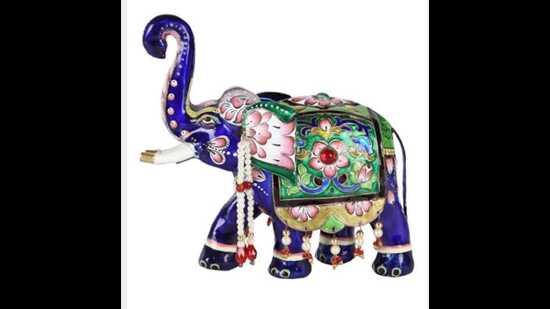G 20 events in U.P.: Kashi’s unique art form to greet foreign delegates
As per officials, the UP government would welcome the delegates with specially crafted cufflinks, made of pure silver with fine gulabi meenakaari work.
VARANASI: The G20 summit meetings are scheduled to be held in several Uttar Pradesh cities like Greater Noida, Lucknow, Varanasi and Agra. However, when it comes to presenting the state’s rich cultural heritage embodied in traditional crafts to guests, it will be the intricate handiwork of the fascinating Kashi. Craft work from this ancient city will welcome the foreign delegates who attend the high-profile summit to be held in February this year.

Officials engaged in preparations for G 20 event in Varanasi said that delegates from more than 40 countries were expected to participate. “The UP government would welcome the delegates with specially crafted cufflinks, made of pure silver with fine gulabi meenakaari work,” said an official requesting anonymity. Several experts of gulabi meenakaari (the art of enamelling and not painting), had been roped in to complete the orders on time, officials said, adding the department of MSME and export promotion, UP has placed an order for over 2,000 cufflinks.
“It’s a great honour for us. We are proud that we will be a part of this grand G20 event and serve it in our own different way,” said Ramesh Kumar Vishwakarma, a gulabi meenakaari craftsman who lives in Varanasi’s Gaye Ghat.
Gulabi meenakaari is one of the rarest forms of craftwork found only in Varanasi, as per Vishwakarma. Highlighting its history, he said it was a Persian art said to have originated in Iran. It was brought to India by the Persian enamellists during the Mughal period. However, over time, it disappeared from other parts of the world but not from Varanasi, where it still exists but with a ‘Banarasi’ flavour.
“Though the art of enamelling originated in Persia, the people here gave it a ‘Banarasi’ touch by adding the beautiful pink colour to it. And this pink colour that is prepared from gold oxide, gave it the name gulabi meenakaari that is found nowhere in the world,” said Vishwakarma, a national awardee who has spent 35 years in this trade.
He said that these cufflinks would be different not only in design but also in terms of artwork. “Each cufflink is going to be unique and there would be no copy. Each would be the first of its kind in the world,” he added.
This is not the first time when gulabi meenakaari artifacts are being used to greet foreign delegates. Prime Minister Narendra Modi first gifted a gulabi meenakaari brooch and cufflinks to US President Joe Biden during the recent G7 summit in Germany in June 2022. This came as a big push to the craftsmen in Varanasi.
Kashi is home to around 80 families, including 400 women, settled in Gaye Ghat and other neighbouring pockets, where they work round the clock to meet the increased demand. These artisans prepare articles ranging from ₹1,000 to several lakhs.
Wood carving
A bulk order has also been given to Kashi’s wood carving artisans. Shubhi Agarwal, a wood carver, said that there was an order to prepare around 2,500 hand painted wooden frames that would also be used to greet the foreign delegates on their visit to UP for the G20 Summit.
How is enamelling is done?
Not only pink but other colours are also used to give life-long hue to the articles. “Blue colour is prepared from cobalt, white from titanium, green from copper, yellow from vanadium and pink from gold oxide. These specially prepared colours are used to give a vivid look to the articles,” Vishwakarma said.
But he hastened to clarify that it was not simple paint work. The entire process required almost 15 days, with seven steps to complete.
First, the design is drawn on paper. The second step is jewellery-making that should either be of pure silver or 22 carat gold and then comes the third step that is perhaps toughest of all: engraving in which the design is engraved on the article.
The fourth step includes meenakaari, where the surface of the article is roughened and colours mixed in sandalwood and rose oil are filled. Next comes the fifth and also the signature step in which the pink colour is applied on the base colours, giving it a beautiful pink coat. Then the artifact is heated at around 850 degrees Celsius to give it a permanent coat. In the sixth and seventh steps, the gems are placed in the artifact and final shape is given to it.





